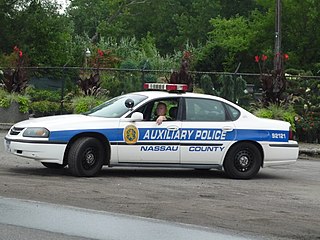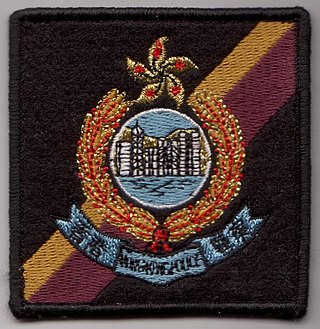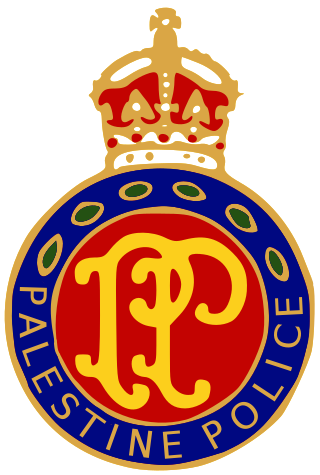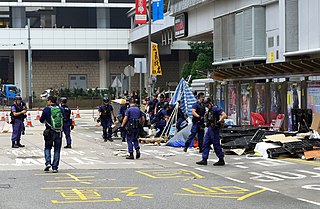Special Branch is a label customarily used to identify units responsible for matters of national security and intelligence in British, Commonwealth, Irish, and other police forces. A Special Branch unit acquires and develops intelligence, usually of a political or sensitive nature, and conducts investigations to protect the State from perceived threats of subversion, particularly terrorism and other extremist political activity.

The Hong Kong Police Force (HKPF) is the primary law enforcement, investigative agency, and largest disciplined service under the Security Bureau of Hong Kong.

Auxiliary police, also called volunteer police, reserve police, assistant police, civil guards, or special police, are usually the part-time reserves of a regular police force. They may be unpaid volunteers or paid members of the police service with which they are affiliated.

A peaked cap, peaked hat, service cap, barracks cover, or combination cap is a form of headgear worn by the armed forces of many nations, as well as many uniformed civilian organisations such as law enforcement agencies and fire departments. It derives its name from its short visor, or peak, which was historically made of polished leather but increasingly is made of a cheaper synthetic substitute.
The Hong Kong Auxiliary Police Force provides additional manpower to the Hong Kong Police Force, especially during emergencies and other incidents.

The Police Tactical Unit is a unit within the Hong Kong Police Force which provides an immediate manpower reserve for use in large-scale emergencies. Unit companies are attached to all land Regions and are available for internal security, crowd control, anti-crime operations, disaster response and riot control throughout Hong Kong. The PTU is often referred as the 'Blue Berets', which is in reference to the blue berets worn as part of the uniform.

Gorget patches are an insignia in the form of paired patches of cloth or metal on the collar of a uniform (gorget), used in the military and civil service in some countries. Collar tabs sign the military rank, the rank of civil service, the military unit, the office (department) or the branch of the armed forces and the arm of service.

The Shanghai Municipal Police was the police force of the Shanghai Municipal Council which governed the Shanghai International Settlement between 1854 and 1943, when the settlement was retroceded to Chinese control.

The Palestine Police Force was a British colonial police service established in Mandatory Palestine on 1 July 1920, when High Commissioner Sir Herbert Samuel's civil administration took over responsibility for security from General Allenby's Occupied Enemy Territory Administration (South). The police force was composed of Jewish, Arab and British officers. However, over the course of the Mandate, the police force became less representative of Palestinian populations and increasingly functioned to repress Palestinian political mobilization and to facilitate the establishment of a homeland for the Jewish people.

Sri Lanka Police is the civilian national police force of the Democratic Socialist Republic of Sri Lanka. The police force is responsible for enforcing criminal and traffic law, enhancing public safety, maintaining order and keeping the peace throughout Sri Lanka. The police force consists of 43 Territorial Divisions, 67 Functional Divisions, 432 Police Stations with more than 84,000 people. The professional head of the police is the Inspector General of Police who reports to the Minister of Law and Order as well as the National Police Commission. The current Inspector General of Police (Acting) is Deshabandu Tennakoon.

The Royal Malaysia Police trace their existence to the Malacca Sultanate in the 1400s and developed through administration by the Portuguese, the Dutch, modernization by the British beginning in the early 1800s, and the era of Malaysian independence.

Law enforcement in Belize is conducted by the Belize Police Department headed by a Commissioner and headquartered in Belmopan City.

Weihaiwei or Wei-hai-wei on the northeastern coast of China, was a leased territory of the United Kingdom from 1898 until 1930. The capital was Port Edward, which lay in what is now the centre of Huancui District in the city of Weihai in the province of Shandong. The leased territory covered 288 square miles (750 km2) and included the walled city of Weihaiwei, Port Edward just to the north, Weihaiwei Bay, Liu-kung Island and a mainland area of 72 miles (116 km) of coastline running to a depth of 10 miles (16 km) inland, an area roughly coterminous with the Huancui District of modern Weihai City. Together with Lüshunkou it controlled the entrance to the Bohai Sea and, thus, the seaward approaches to Beijing.
The 1st Chinese Regiment was a British Colonial Auxiliary Forces regiment raised in British Weihaiwei. The regiment, which was praised for its performance, consisted of Chinese enlisted men serving under British officers.

The Special Tactical Contingent, nicknamed the "Raptors", commonly known as the Special Tactical Squad (STS), is a specialist riot contingent of the Hong Kong Police Force under the command of the Police Tactical Unit (PTU).

The 2019–2020 Hong Kong protests were a series of demonstrations against the Hong Kong government's introduction of a bill to amend the Fugitive Offenders Ordinance in regard to extradition. It was the largest series of demonstrations in the history of Hong Kong.
The Hong Kong Police Force (HKPF) is structured into numerous bureaus and units. As a whole, it is commanded by the Commissioner of Police, who is assisted by three deputy commissioners. The "Deputy Commissioner – Operations" supervises all operational matters including crime. The "Deputy Commissioner – Management" is responsible for the direction and co-ordination of force management including personnel, training, and management services. The “Deputy Commissioner — National Security” is responsible for the National Security Department, which deals with acts of sedition, terrorism, and collusion with foreign governments.

The Hong Kong Police Force (HKPF) struggled with corruption among its ranks from the 1940s until the 1970s. It gained the nickname "Asia's Finest" after undergoing reforms in 1979. Since the 2010s, the force has faced allegations of police brutality, sexual assault, excessive use of violence, falsification of evidence, and a lack of professionalism.
Rupert Timothy Alan Dover is a retired British-born Assistant Commissioner and Regional Commander of Kowloon West with the Hong Kong Police Force. He retired from the police force in January 2024.


















